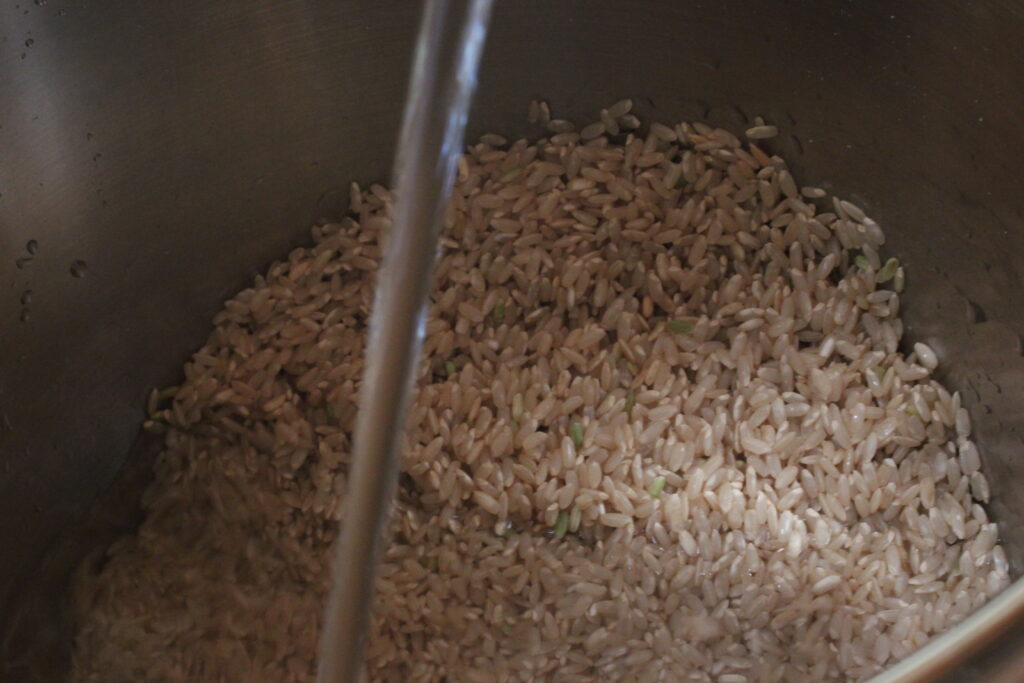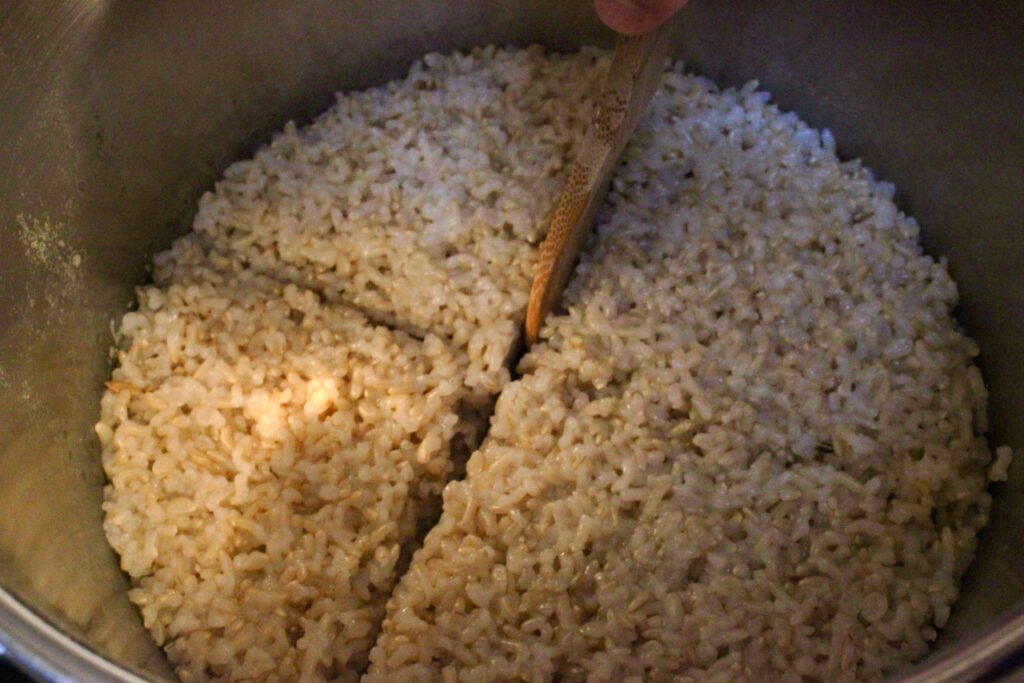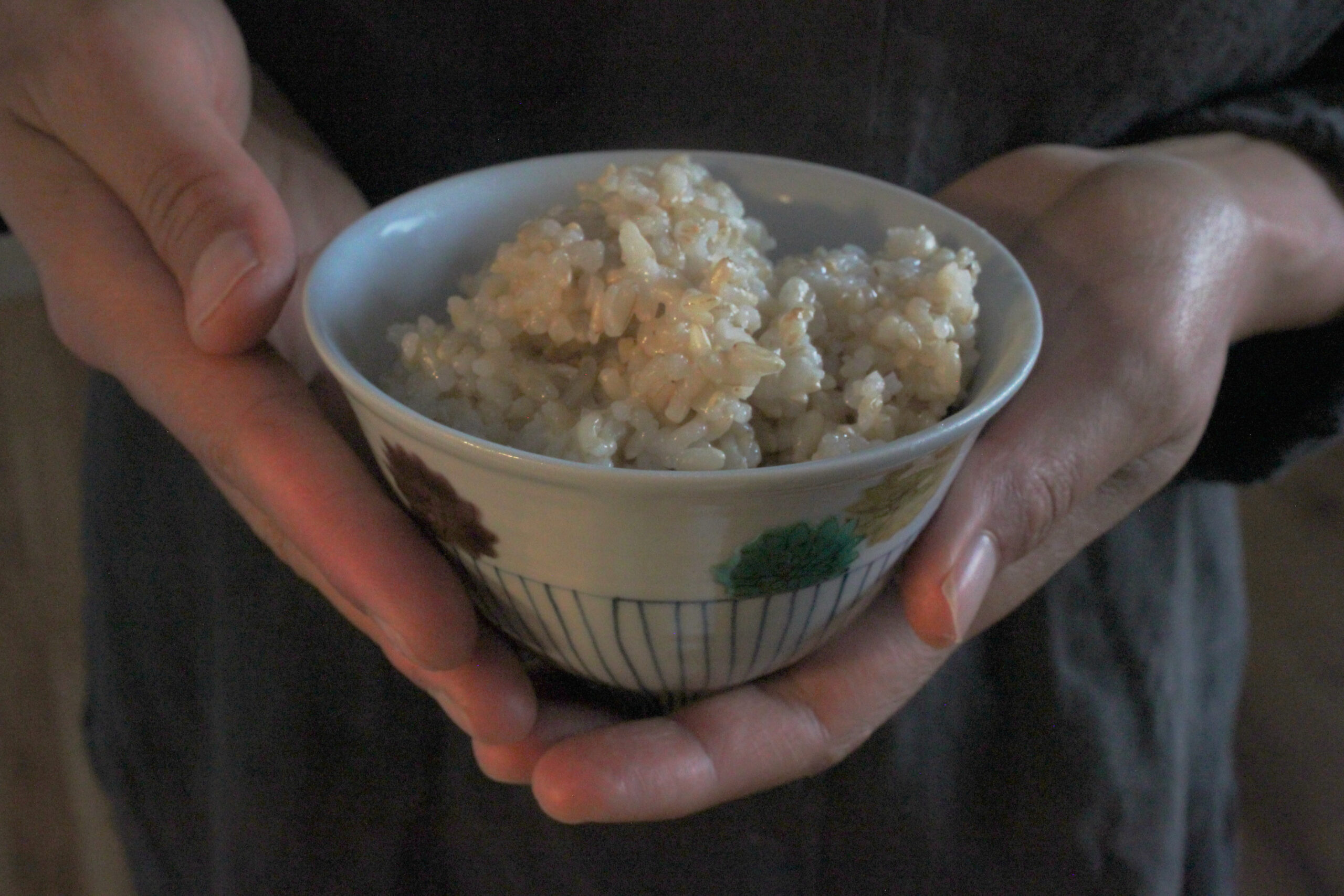Cooking rice is one fo the most basic and essential steps in Japanese cooking. While plain rice is considered to be a rather bland and uninteresting minor part of the meal in many different cultures around the world, Japanese people take rice quite seriously. When the rice is well prepared, you can expect the quality in the rest of the meal. It is, indeed, surprising how good quality rice tastes, which is completely different from the so-called “average rice.” Rice can be so delicious that you can feel such satisfaction and pleasure just eating it by itself; it can give you the feeling that you don’t need anything else but savoring and enjoying this bowl of rice.
Choosing the quality of rice
What makes the difference? First, choosing the quality of rice grains. Choosing organically grown brown rice is the place to start. Rice grains grown without any pesticides or chemical fertilizers have their natural life force within. The conscious care of the farmers is also definitely reflected in its taste and energy. At the same time, living in the United States where there are many large scale of organic farms, I searched for further quality. Instead of buying rice from the major organic rice brand, I looked for the one that is cultivated in a smaller scale farm by the farmers who grow the rice with love, pride, and care. That is how I found Chico Rice, which is cultivated by the dedicated rice farming son and father who grow the rice organically, milling it and packaging it by themselves. I was so excited when I found them, and I ordered it immediately. It has indeed not fallen short of my expectation. Every bite is a pleasure. It’s the first rice I encountered in this country which genuinely made me want to eat more of it, because it’s so delicious—like the feeling I would have when I eat good Japanese rice.

Soaking is essential!
Secondly, the taste of rice as well as the quality of its digestion are significantly influenced in the phase of preparation. Soaking is the very essential step for cooking the most delicious and healthy rice at your home. Especially with brown rice, the soaking process softens the outer husk which makes it more digestible, hence making all the valuable nutrients available for the body. Eating brown rice without soaking, in fact, could strain the digestive organs due to its hard fiber. Moreover, when you soak the rice for over eight hours and let it germinate, the nutritional value increases significantly. I soak it for about 24 hours. As the rice reaches close to sprouting, the amount of GABA (the naturally occurring amino acid which works as the neurotransmitter to the brain as anti-stress and anxiety) increases significantly.
But this additional soaking step makes not only a difference to these nutritional values but also in the taste. The rice becomes so much more delicious, gentler, and fluffier!!
Choice of the pot
Another aspect that decides the difference in the taste of the rice is how (with what) to cook. Here, we don’t have any right or wrong. Depending on the pot to cook the rice, the result becomes quite different in the texture, flavor, and energy. Below, I am introducing four different ways of cooking rice.
- Pressure Cooker
This is my absolute favorite way of cooking rice. When you cook rice with a pressure cooker with simmered heat for 45 minutes or so, the texture of the rice transforms. It becomes so moist and chewy. The sweetness also increases, and it becomes absolutely satisfying just by itself. At the same time, since the pressure cooker brings more heat and concentrated energy (both yang energy) into the rice, it is more suitable for the cooler season. In the warmer season, we might want to bring in a little lighter and cooler energy to our body. This can be also said for people who tend to have excess heat in the body. In that case, cooking rice with the pressure cooker might not be the best option for them. Cooking for a shorter time or cooking with the stainless or earthen pot will be a good choice.
- Stainless Pot
This is probably the most standard way to cook rice. Since it is cooked with the usual heat, the texture of the rice becomes on the lighter side, hence the rice is more pearly and a little harder. I find that it goes very well with the western style dishes. When you cook rice with the stainless pot, I highly recommend to soak the grain well prior to cooking, since the heat won’t break down the fiber as much as the pressure cooker or cast iron pot. It is a good way to cook it all year round.
- Cast Iron Pot
Not as much as the pressure cooker, but this is certainly another option to cook rice while breaking down its fiber effectively. It also won’t be as chewy and soft as cooking with the pressure cooker, but it makes the rice softer, moister, more heat retaining, and easier to digest compared to cooking with the stainless pot.

- Earthen Pot
This might not be a common option for many, and yet cooking rice with an earthen pot is something very special. Like cooking with cast iron, it retains the heat deeply and breaks down the fiber more than cooking with the stainless pot. At the same time the texture and taste of the rice becomes gentler and somewhat earthy. I use this option when I make Japanese food in the summer season. While rice cooked with the pressure cooker could create too much heat in the body, rice cooked with an earthen pot brings more balance, groundedness, and lightness to our body which has been exposed to the sun and heat.

Q&A
Cook with salt or without salt?
In the macrobiotic diet, people cook rice with kombu seaweed or salt. Some people also change the amount of salt according to the phase of the moon. But I always cook without any salt. In my opinion, salt is used enough in the cooking and there is no addition needed. And when you cook good rice in the right way, it is so delicious that you have no need to cook with any seasoning.
What if I forgot to soak the rice?
Yes, this happens. Of course, it is much better to soak the rice prior to cooking, but don’t feel discouraged to cook rice. You can do the “slow cooking” in such case. With slow cooking, you start cooking rice at medium heat and slowly bringing it to a boil. This allows the rice grain to soak in the moisture more effectively, hence the rice gets cooked more thoroughly at the end.
What do I do with the leftover rice?
Put in the tightly sealed container and store it in the fridge or freezer. The tightly sealed container is helpful to retain moisture in the rice. You can store it in the fridge for a few days. When you are ready to eat, you can steam it (I personally don’t use a microwave in my cooking). Through steaming, you can get the consistency of the rice close to the freshly cooked state. The frozen rice could get somewhat more pearly. You can bring it to room temperature and steam as well. I personally use it for fried rice or rice porridge.
How to cook brown rice
- Rinse the rice with filtered water a few times. It is important to use the purest water you can, since the rice will start to soak it up from the moment it comes into contact. When you pour the water onto the rice for the first time, it is a significant moment for the rice to reunite with the water element after being harvested, dried, and stored. So, do it gently. When the water is poured, stir with care in a clockwise motion and drain the water. Repeat it until the water becomes clear.
- After the last rinse and drain cycle, put the rice in the pot you will cook it with, then pour in one and a half to two times more water. The amount of water depends on the nature of the rice grain you use, what kind of pot you use, as well as the consistency you want to realize. When I cook with the pressure cooker, I pour about one and a half times more water, whereas with the stainless pot and cast iron pot, I pour about two times more water. This soaking process can also be done in a bowl, and you can transfer the water and rice into the pot just before cooking.
- Let it sit for at least 8 hours.
- When the rice is ready to be cooked, there is an option for you to drain the water and refill the fresh water into the pot. It depends on how long you soak the rice for. When I soak for around 8 hours, I use the water that I soaked it with. When I soak it for around 24 hours, the water would get bubbly and might have some particular smell. If the smell is strong, I pour out the water into the measuring cup, and add the equal amount of fresh water.
- Turn the heat up to high and bring it to a boil. Once boiling, turn the heat to low. With the pressure cooker you cook 30-45 minutes more, depending on your preference for the consistency. With the other kinds of pot, you cook 45 minutes to one hour more. The longer you cook, the chewier it will become.
- Turn the heat off and let it sit for about 15minutes. This process is very important to let the rice settle and be steamed at the end.
- Open the lid of the pot. With the wetted wooden or bamboo spoon, cut the rice across into four equal parts and flip each section upside down. Japanese people call it’ “flipping heaven and earth.” Mix it, fluff it up, and serve.

Rice grain meeting water 
Rinsing well 
Soaking for over 8 hours 
Cutting cooked rice across four parts 
Flipping heaven and earth


1 thought on “The Essentials of Cooking Rice”